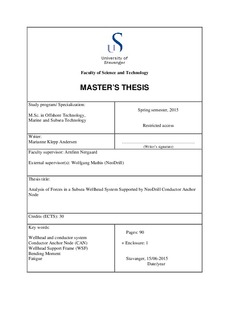| dc.contributor.author | Andersen, Marianne Klepp | |
| dc.date.accessioned | 2015-09-28T08:31:24Z | |
| dc.date.available | 2015-09-28T08:31:24Z | |
| dc.date.issued | 2015-06-15 | |
| dc.identifier.uri | http://hdl.handle.net/11250/302128 | |
| dc.description | Master's thesis in Offshore technology : subsea technology | nb_NO |
| dc.description.abstract | During drilling operations the marine drilling riser is exposed to environmental loads like waves and currents, as well as loads from the rig. These environmental loads are transferred from the riser to the wellhead system. Large bending loads will occur along the wellhead and conductor system. The loads will fluctuate in time and can cause fatigue damage accumulation at connectors and welds present in the system. At present, the fatigue performance is believed to be a concern for a growing number of operations. This report investigates how the distribution and magnitude of the bending loads will change in different conditions. This is done to identify a method to achieve an optimum distribution and position of critical bending moments. Additionally, a discussion on whether a change in distribution and magnitude of the bending moments will reduce fatigue accumulation in critical points is given.
A global riser analysis is conducted using the computer software OrcaFlex to study how the bending moments behave under different conditions. The analysis is run for three different scenarios with the intention of comparing results.
The results show that the bending moments will behave differently under various conditions. In soft soils, the largest bending moments will occur at a depth of 5 to 10 meters below the seabed surface. Furthermore, it is shown that the magnitude of the bending moments will increase in soft soils. The weight of the blow out preventer will also affect the bending moments. In soft soils, the lateral resistance is reduced, thus a lager lateral displacement of the blow out preventer can occur. The aforementioned can cause fatigue accumulation along critical hotspots within the wellhead and conductor system. The conductor anchor node is designed to carry heavy blow out preventers and gives the system a high lateral stiffness. The large bending moments occurring below the seabed surface will be reduced when the conductor anchor node is applied. The conductor anchor node will most likely reduce the fatigue accumulation at critical points below the seabed. Larger bending moments will occur on top of the conductor anchor node and will most likely expose connectors and welds above the seabed for somewhat increased fatigue damage.
A wellhead support frame can be installed on top of the conductor anchor node to support the high-pressure wellhead. The wellhead support frame will increase the systems stiffness, thus larger bending moments will occur on top of the wellhead support frame. The results give a clear indication that a redistribution and change in magnitude of the bending moments are achievable. The conductor anchor node gives the engineers a tool enabling an optimized system for maximum fatigue life below seabed surface. Without the conductor anchor node there is no possibility to change the characteristics of the seabed. However, it is difficult to identify one method to achieve an optimal distribution and position of bending moments, but it is possible to redistribute the bending moments and shift the problem to less critical locations in the system. | nb_NO |
| dc.language.iso | eng | nb_NO |
| dc.publisher | University of Stavanger, Norway | nb_NO |
| dc.relation.ispartofseries | Masteroppgave/UIS-TN-IKM/2015; | |
| dc.rights | Navngivelse-Ikkekommersiell-IngenBearbeidelse 3.0 Norge | * |
| dc.rights.uri | http://creativecommons.org/licenses/by-nc-nd/3.0/no/ | * |
| dc.subject | wellhead and conductor system | nb_NO |
| dc.subject | conductor anchor node (CAN) | nb_NO |
| dc.subject | wellhead support frame (WSF) | nb_NO |
| dc.subject | bending moment | nb_NO |
| dc.subject | fatigue | nb_NO |
| dc.subject | subsea technology | nb_NO |
| dc.subject | offshore teknologi | nb_NO |
| dc.subject | undervannsteknologi | nb_NO |
| dc.title | Analysis of forces in a subsea wellhead system supported by NeoDrill conductor anchor node | nb_NO |
| dc.type | Master thesis | nb_NO |
| dc.subject.nsi | VDP::Technology: 500::Marine technology: 580::Offshore technology: 581 | nb_NO |

